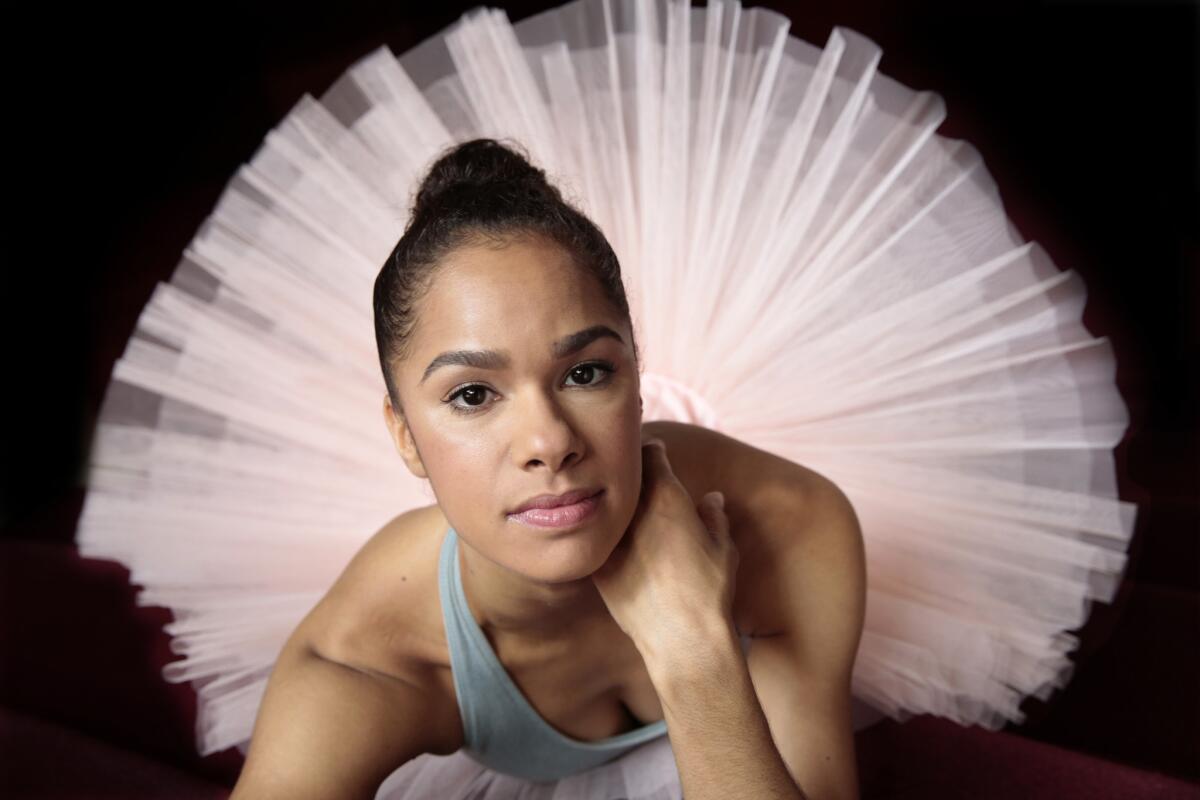Misty Copeland shouldn’t have to fight ballet’s racist past alone

- Share via
Some days, you just want to invite Misty Copeland over and offer her a spa day —or better, organize a rally for her and make sure she knows that you get why she objects to Russian dancers wearing blackface. Copeland is a brilliant dancer who is black; she should enjoy dancing, being the first female African American principal at American Ballet Theatre and representing diversity in ballet — but she shouldn’t have to fight ballet’s racist past all by herself.
Yet on Instagram and Twitter, Copeland — who was discovered at 13 in San Pedro — has been valiantly trying to offer her experience as a woman of color and a dancer to make people understand why a photo of two Bolshoi dancers in full-out blackface is offensive. And for this, she gets hate, trolls and lots of grief.
To be clear, the photo that started it all does not just show two white dancers made up with realistic darker skin in order to fill two roles African American dancers might play. The parts they dance in “La Bayadere” are servants of the Golden Idol in a ballet with many “exotic” fantasies, supposedly set in India. There’s no ethnographic verisimilitude here. These are secondary characters who do not have to be black.
They might well want to be gold, to match the idol they accompany — except that they represent a servant stereotype from another era. Their choreography involves hopping from side to side with splayed fingers, seemingly a crude imitation of African dance. Nor is their skin simply darkened to play another ethnicity. Often played by student dancers, the servants wear blackface, a convention that features exaggerated dark skin, red lips and eyes circled in white.
“But we’ve always done it this way!” Russian partisans cry. And “it’s not racist to us!” They actually say this. In addressing Copeland’s criticism, Bolshoi officials claimed no one has ever complained, not since the ballet premiered in 1877. The Bolshoi says they want to keep their original tradition, but that rationale doesn’t exactly stand up. Over the years, much has altered in their production. Technique changes, costumes and sets are redesigned, the Golden Idol is sometimes called the Bronze Idol and each male dancer may alter the solo’s steps to suit.
Ballets change considerably over time, yet the Bolshoi says they won’t consider eliminating racist stereotypes. Because, they offer, they are unaware of them.
Earth to Bolshoi: It’s the 21st century, and modern society cares about such cavalier refusals. All dance reflects the culture in which it develops, so do they really want to die on the hill where 19th-century choreographers reflected racial insensitivity? Ballet changes when it wants to. If the original choreographer Marius Petipa saw the revealing costumes and 6 o’clock arabesques of today, he might well object. Back then, after all, they never did it that way.
Nor are these “Bayadere” characters the only ballet blackface roles that could be revised. The Moor in choreographer Michel Fokine’s “Petrushka” comes to mind, another careless stereotype. The character needs to be boorish, libidinous, simple-minded — but not black. Some traditions are simply worth preserving more than others. Laws change, language changes, ideas and sensitivities change. Ballet has no need to cling to old portrayals. Not all history is valuable enough to repeat.
Can ballet come to grips with its racist past? A few smart alterations can update old characterizations. Recently, companies performing “The Nutcracker” have discovered that their Chinese dance can be fun and reflect actual Chinese elements, not demeaning stereotypes — thank you, Final Bow for Yellowface movement. The organization educates about the racist history of Asian stereotypes and advises how to avoid them. No one gets hurt, no history is harmed. Surprise! You can dance musty old ballets with all sorts of renovations that don’t harm their original appeal.
Think of it this way, all you defenders of old Russian stereotypes. What if the exaggerated demonization of Russians during the Cold War had become a set of popular characters in much-repeated Western ballets performed around the world? What if Americans cherished and defended the roles of The Godless Communist, or the Russian Bear who abuses children that were actual stereotypes of the time? Is it OK just because it’s history?
Blackface in ballets today? Really? Give it up and live on the right side of history. Copeland is not the only one noticing, nor should she be.
Jennifer Fisher is a dance studies scholar at UC Irvine and author of “Ballet Matters” and “Nutcracker Nation.”
More to Read
A cure for the common opinion
Get thought-provoking perspectives with our weekly newsletter.
You may occasionally receive promotional content from the Los Angeles Times.






